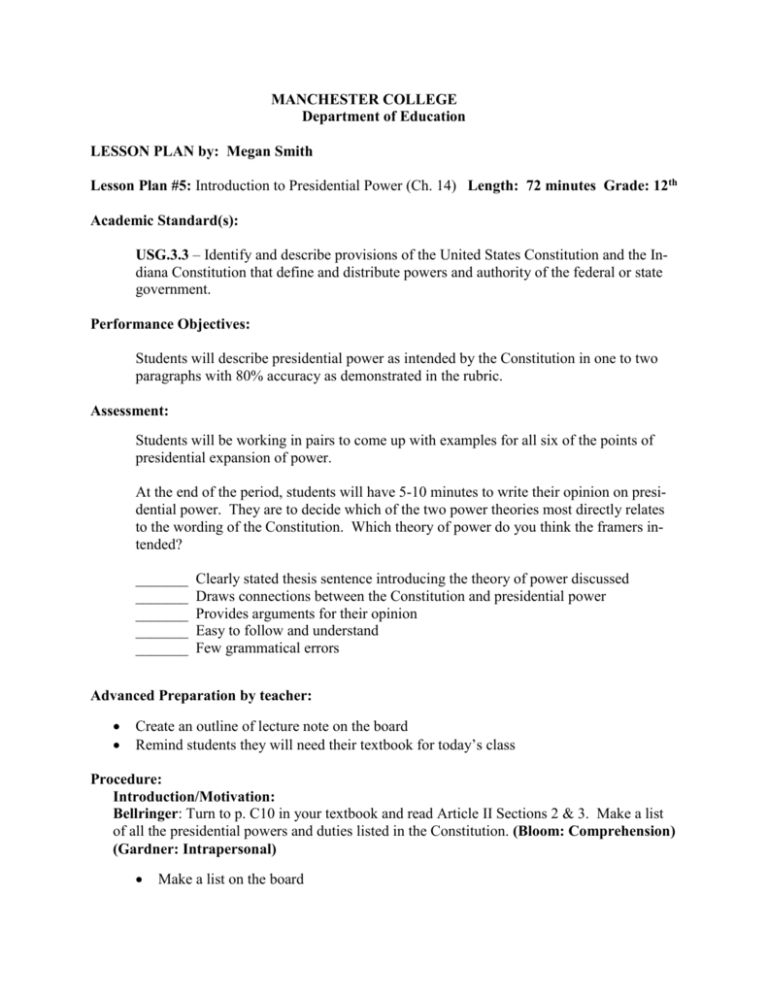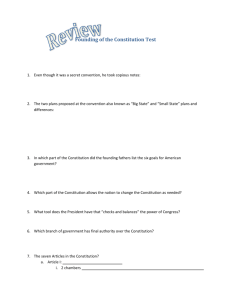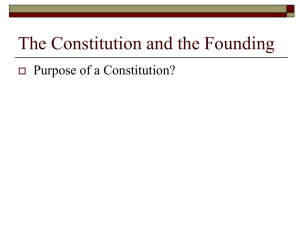Executive Branch - About Manchester
advertisement

MANCHESTER COLLEGE Department of Education LESSON PLAN by: Megan Smith Lesson Plan #5: Introduction to Presidential Power (Ch. 14) Length: 72 minutes Grade: 12th Academic Standard(s): USG.3.3 – Identify and describe provisions of the United States Constitution and the Indiana Constitution that define and distribute powers and authority of the federal or state government. Performance Objectives: Students will describe presidential power as intended by the Constitution in one to two paragraphs with 80% accuracy as demonstrated in the rubric. Assessment: Students will be working in pairs to come up with examples for all six of the points of presidential expansion of power. At the end of the period, students will have 5-10 minutes to write their opinion on presidential power. They are to decide which of the two power theories most directly relates to the wording of the Constitution. Which theory of power do you think the framers intended? _______ _______ _______ _______ _______ Clearly stated thesis sentence introducing the theory of power discussed Draws connections between the Constitution and presidential power Provides arguments for their opinion Easy to follow and understand Few grammatical errors Advanced Preparation by teacher: Create an outline of lecture note on the board Remind students they will need their textbook for today’s class Procedure: Introduction/Motivation: Bellringer: Turn to p. C10 in your textbook and read Article II Sections 2 & 3. Make a list of all the presidential powers and duties listed in the Constitution. (Bloom: Comprehension) (Gardner: Intrapersonal) Make a list on the board Explain to the class that the last chapter discussed how the President gets elected; now this chapter is completely dedicated to the many powers of the President. We will first examine what the Constitution says about his powers and then move to how the powers have expanded throughout the years. Step-By-Step Plan: Begin the following lecture notes on the board: Growth of Presidential Power Experts sometimes call Article II, the most “loosely drawn chapter” of the Constitution. What do you think the framers had in mind? Why is the wording of the Constitution so broad? (Bloom: Analysis) - Big fear of tyranny, just broke away from Britain The power of the Presidency has grown considerably since FDR. It is sometimes characterized as traditional and modern approaches. The modern presidency is distinguished by four features: 1. The president is expected to develop a legislative program and to persuade Congress to enact it a. Discuss what this means 2. Presidents regularly engage in direct policymaking through actions not requiring congressional approval a. How can this be done? (Bloom: Application) 3. The presidential office has become an extensive bureaucracy designed to enable presidents to undertake points 1 and 2 a. How is the president able to accomplish so many things? (Bloom: Knowledge) 4. Presidents have come to symbolize the nation and to personify its government to such an extent that the public holds them primarily responsible for its condition and closely monitors their performance through intensive media coverage a. What are some examples of how this last point has taken shape throughout your lifetime? (Bloom: Evaluation) Executive branch has grown considerably without changes to the Constitution, but how? The power has to be coming from somewhere. Let’s look at the political cartoons on page 402. What are the cartoons suggesting? (Bloom: Analysis) (Gardner: Visual/Spatial) 1. 2. 3. 4. Unity of presidency Authority delegated by Congress Citizen’s demand for leadership President’s ability to act quickly during crises 5. President’s views and way of fulfilling roles 6. President’s ability to use media At this time, ask students to get with a partner and come up with an example for each of the changes. (Bloom: Application) (Gardner: Interpersonal) Students should use their textbook as well as prior knowledge from the course. To get them started, do number 6 together. This will be turned in! There are numerous examples of how presidents use media to expand their presidential powers. Limits to growth of power We are going to take a look at two examples of how the president’s powers have been limited: 1. Korean War (1952): labor disputes threatened to shut down steel production a. Truman ordered Secretary of Commerce to seize control of several steel industries for the war effort b. Supreme Court decided not within constitutional boundary, Congress’ power only 2. George Bush (2006): tried to use military tribunals to prosecute “enemy combatants” at Guantanamo Bay, again deemed unconstitutional; Congress’ power Presidential View - Each individual view of the presidents determine the span of presidential power There are three current theories regarding to executive power 1. Stewardship theory – idea that the President can do anything that isn’t explicitly forbidden by the Constitution (Roosevelt) 2. Constitutional theory – presidential power is strictly limited – powers only granted by Congress or specifically listed in Constitution (Taft) 3. “imperial Presidency” – too powerful Presidency; takes action without consulting Congress or the American people Closure: At this time, students are to decide which of the two power theories most directly relates to the wording of the Constitution. Which theory of power do you think the framers intended? Students must turn this in before they leave the classroom. (Bloom: Analysis/Evaluation) (Gardner: Verbal/Linguistic) Adaptations for gifted/talented: For the closing writing assignment, students should be assigned this question instead: Look at today’s President. Decide which theory you think he models and explain why you think that. For the group work, student could be challenged by asking him/her to come up a specific President to go along with each of the six expansions of power. For the Bellringer assignment, instead of regurgitating the exact words of the Constitution, student should find the power listed and write it in their own words. The entire lesson is full of questions to check for understanding. I would ask the student specific questions to challenge and push their understanding. The other students could benefit from a student’s analysis of the topic. Self-Reflection: Were the students engaged in the lesson? Were there any portions of the content that seemed particularly difficult? Were the students able to come up with examples for the six growths of power? Gifted/Talented Students The Executive Branch Unit is a unit that has a lot of natural potential for gifted and talented students. U.S. Government is a class that is designed for seniors in high school and typically only lasts one semester. Because of that, most of the content is taught at surface level and rarely goes much deeper. Throughout the entire course there are multiple avenues for additional learning and deeper thinking. The Executive Branch in particular is a very interesting topic that students will be confronted with throughout their entire lives. The most beneficial enrichment that I think could come from this chapter would be an indepth look at the issues being pursued by the current administration. Unfortunately, the standards do not spend a sufficient amount of time on the current workings of the Presidency and how it will and does affect our lives. From my student teaching experience, I learned how interested in politics the students were. To enrich a gifted student, I would have them take a look at the political world and maybe even present their findings to the class. Writing a persuasive essay about a specific topic would also be beneficial. Instead of reading the textbook, I think it would be very enriching for gifted students to read the primary source documents of the framers to gain a better perspective of how and why the Constitution was written in terms of the Executive Branch. The state standards focus heavily on the intent of the framers and controversies of the Presidency; however they do not discuss the Federalist Papers or any other document that directly reflects the intent. I would assume that is because the documents can be difficult to read without guidance. I think that a gifted student would find them interesting and supportive of class content. U.S. Government is very much application based, but there is little time to do that because it is so content heavy. With almost any lesson, gift students could be provided the opportunity to research the history, controversy, or current day administration. I think both teachers and students would benefit from these enriching assignments.











